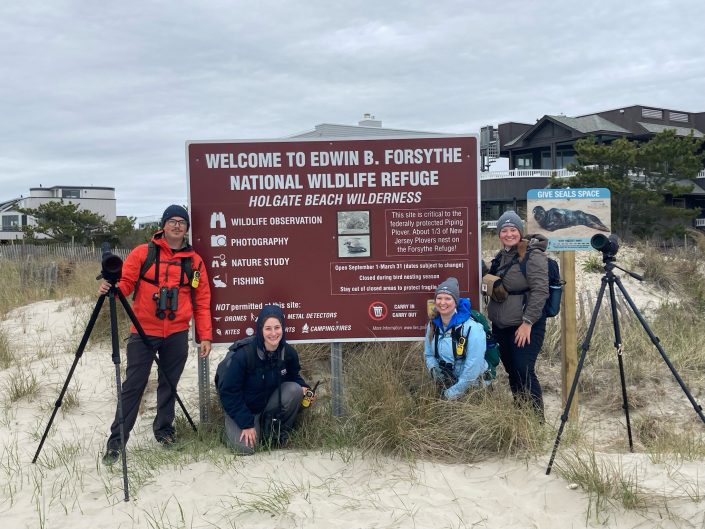Beach Nesting Bird Monitoring is Underway at the Edwin B. Forsythe National Wildlife Refuge
by Todd Pover

For the past eight years, CWF has been contracted by the U.S. Fish and Wildlife Service through a cooperative agreement to provide monitoring and management of beach nesting birds at the Edwin B. Forsythe National Wildlife Refuge. The Refuge nesting sites – both the Holgate and Little Beach Island Units – provide some of the only habitat in the state closed to the public and free of human disturbance and detrimental beach management practices. The habitat at the sites is especially suitable for the state endangered piping plover as a result of optimal nesting conditions created by Superstorm Sandy and largely sustained since then through winter storms. As of the 2021 season, the Refuge sites had the highest concentration of piping plovers in the state, with Holgate having by far the most pairs (46). Furthermore, on average in recent years, Holgate has produced a higher fledgling rate than many sites in the state.
Monitoring all those pairs, as well as the American oystercatchers, least terns, black skimmers, and common terns that also nest at the Refuge is no small task. Each spring, CWF hires a team of seasonal field technicians to locate nests, determine breeding success, place predator exclosures around nests, and complete other critical tasks necessary to track recovery and provide protection to these imperiled species. As you can imagine, the job is both very rewarding and physically (and emotionally) demanding.
“We often overlook the critical role seasonal staff plays in endangered species recovery, especially for resource-intensive work like that needed for piping plovers,” says Senior Wildlife Biologist Todd Pover, who heads up the Forsythe project for CWF. “We simply couldn’t get all the work done without them, they provide ‘frontline’ protection for the birds and intensive on-the-ground data collection, which are the core tasks of our recovery program.”
Heading up this year’s seasonal team at Forsythe is Emmy Casper, who is returning for her third year on the project, and first as the Field Crew Leader. Emmy has a master’s degree in biology from Fordham University and brings a wealth of skills to the job from her previous years’ experience. Amy Kopec, also comes to the team this year with previous “beachnester” experience, in her case two years at Crane Beach, one of the major piping plover nesting sites on the North Shore of Massachusetts. Erin Foley is returning to CWF to join the Forsythe project after being our beach monitor at the National Guard Training Center last summer. Jacob Miranda is new the to beach nesting bird world but has held several other field positions involving birds and is headed off to pursue his master’s degree later this summer. Lexie Lawson is new to birding field work but is currently working on her master’s degree in biology at Montclair State University. Rounding out this year’s crew is Dakota Bell, who will be joining the team later in May after she completes her studies at Stockton University.
Certainly, the beach nesting birds at the Refuge are in good hands this season. The seasonal crew has been at it for over a month already, and even though the first piping plover and American oystercatcher nests have been found and least terns are just arriving, it is far too early to provide any insight on what type of breeding year we will have. We will provide periodic updates throughout the season but in the meantime, please welcome our 2022 monitoring team!

Discover more from Conserve Wildlife Foundation of NJ
Subscribe to get the latest posts sent to your email.